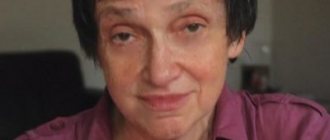Why is it important to start treatment in a timely manner?
Cognitive impairment has three degrees of severity. In the initial stages they cause minor discomfort, but in the later stages they significantly worsen the quality of life.
- Mild violations. With mild cognitive impairment, concentration decreases, memory deteriorates slightly, and the patient quickly gets tired during certain types of intellectual activity.
- Moderate. Memory deteriorates more severely, and lapses may occur. Patients forget some events in life, the way home.
- Heavy. The patient cannot take care of himself, is disoriented in time, does not remember recent events, and forgets his home address. Sometimes patients suffer from hallucinations, delirium, and urinary incontinence.
To prevent the development of severe symptoms, it is important to consult a doctor promptly and begin treatment.
What does this concept mean?
Having high cognitive abilities means being able to use the information we receive from the environment. This includes all types of mental activity: memorization, processing, data analysis. These are mental processes during which all information received now or previously received is processed and becomes suitable for its further use in life.
In simple terms, cognitive ability is the ability to use your brain.
If a person has them at a high level, then he can fully use the brain: remember, draw conclusions, apply knowledge in everyday life, change his mind, etc.
How to diagnose and treat cognitive impairment
- We interview the patient, relatives, examine the patient and conduct neuropsychological tests to determine the condition and make a diagnosis.
- For initial forms of disorders, we prescribe a course of vitamins and amino acids.
- We prescribe neuroprotective drugs that improve cognitive functions, and drugs that affect the cause of the disorder and eliminate it.
- We organize classes with a psychologist and conduct trainings that help improve cognitive functions.
Praxis
Another brain skill that is extremely developed in the human individual is praxis. Praxis refers to the ability to make complex, purposeful movements according to a pre-thought-out plan. We are not talking about withdrawing a hand from a hot frying pan or, say, breathing movements - these actions are carried out reflexively, we do not think about them. After all, even if you try to purposefully hold your breath and limit the access of oxygen to the body, then as soon as you lose consciousness, the brain will immediately again send a signal to the respiratory muscles to quickly begin exhaling carbon dioxide and inhaling oxygen (do not repeat at home).
We are talking about complex actions that consist of many simple ones. For example, take a toothbrush, paste, unscrew the cap, squeeze a little paste onto the brush, screw on the cap, put the brush in your mouth, thoroughly brush your teeth, not forgetting about your wisdom teeth. Or, for example, the ability to repeat actions after someone, as in dance lessons, looking both at the teacher and at your crooked stance reflected in the mirror.
Such complex motor acts are formed with the participation of a colossal number of systems, and not just the motor system, as one might assume.
Firstly, this is information entering the sensitive cortex from proprioceptors. These are special receptors of muscles and joints that tell the brain about how the body is located in space: at what angle the arm is bent at the elbow joint, which leg the owner is leaning on, whether the butt is sitting on a chair or just leaning slightly against the wall.
Secondly, these are the eyes and visual cortex, because movement, especially multicomponent movement, is always carried out under the control of vision.
Thirdly, these are the ears and auditory cortex. Imagine yourself learning a new skill. Agree, if clear instructions are given and the sequence of actions is announced, it is much easier to learn.
Finally, the motor system with the motor cortex. If limbs are involved in movement, this is one part of it, if speech and the articulatory apparatus are involved, then another, in strict accordance with the map of the body, the homunculus. It is here that the idea of movement is born and a signal is sent to a bunch of muscles, which must contract in a strictly defined sequence and produce movement, beautiful, accurate and coordinated.
If a praxis disorder is suspected, the neurologist at the appointment may ask the patient to repeat simple finger movements after him. The doctor shows a fig, Victoria or horned goat, a patient with motor apraxia sees, understands what they want from him, but cannot put his fingers together.
Disorders of the praxis function are called apraxia. Apraxia, like speech impairment - aphasia, is a collective concept that includes various symptoms and syndromes: it all depends on which link in the praxis chain is broken. In practice, apraxia looks very strange. People with a violation of this function cannot perform this or that action; the muscles literally do not obey. It is curious that the strength of the muscles itself is completely preserved; the same parts of the body take part in simpler motor acts without problems, fully performing their functions.
Unlike speech, there is no specific area of the brain that is responsible for praxis. Praxis is encoded in connections between areas of sensory, motor, visual, auditory and other cortical centers. The development of apraxia is usually caused by diseases that affect the white matter and fibers connecting distant areas of the cerebral cortex or areas of the tertiary cortex. This could be a stroke, multiple sclerosis plaque, neurodegeneration, or an infectious lesion of brain tissue. The result is the same - a violation of the motor act.
Praxis has two main types of violation - a violation of the action itself, the sequence of movements, and vice versa, a violation of the idea of movement, an incorrect message from the brain. For clarity, let's look at examples.
A person with motor apraxia is unable to perform a goal-directed action. For example, it’s getting late in the evening and the room becomes dark. Based on past experience and memory, the brain realizes that it should press the switch, and then the electricity will do its job. Neurons in the motor cortex send signals to the hand, telling it to lift off the knee, straighten up, turn to the right and pull the cord of the floor lamp. Unfortunately, this is not possible with motor apraxia. The hand does not listen to the head. She can move, move to the right or left, but it’s impossible to assemble these simple movements into a chain of sequential actions.
Ideation apraxia is caused by the loss of a plan of action. Patients with this type of apraxia have difficulty performing any movement on demand, that is, the muscles listen to the brain and move, but initially the wrong plan of action leads to a meaningless set of movements. If you ask a person with ideation apraxia to show how he would light a cigarette with matches and smoke, he will most likely do the following: he will take the cigarette, strike the box with it, and then bring the match to his mouth.
To test this area of activity during an appointment, we ask patients to imitate certain actions. For example, you can ask them to brush their teeth with an imaginary toothbrush or comb their hair with an invisible comb and put their hair in a ponytail. It turns out that such simple tasks can throw a person with apraxia into a stupor: someone will raise their hand only to shoulder level, someone will bring a brush to their mouth but forget to brush their teeth, or will look at the non-existent comb in their hand and think, how the hair is being done.
A fairly common symptom found in older people is apraxia of gait. With normal leg strength, intact sensitivity, and intact vestibular function, a person suddenly forgets how to walk. The gait in this condition resembles the gait of a baby who is just learning to walk. The stride is short and asymmetrical, the legs are set wide apart, careful visual control and support on a cane or grandson are required.
It is interesting that patients themselves often cannot describe their condition; instability and changes in step are subjectively perceived as dizziness, although the vestibular apparatus works quite well. Neurologists call unsteadiness without the feeling of a “helicopter”, nausea and vomiting “non-systemic dizziness”.
Unfortunately, quite often, even too often, complaints of “non-systemic dizziness” lead doctors to think about impaired blood circulation in the cerebellum (there is a rational grain, because it is responsible for the coordination of movements). The result of a hasty decision is the prescription of incorrect treatment, designed to ultimately cleanse these dirty vessels that carry blood to the cerebellum.
The trouble is that gait apraxia develops when the frontal lobes of the brain are affected, and not the cerebellum.
And it can be treated (or at least maintained at the existing level) by constant exercise, physical activity, and learning to walk again. Our connectome In 2005, the term “connectome” was coined. It means all neurons and all connections between them. does not sleep, it only needs to be constantly fed with signals from our body.
According to the unscrupulous, gossip-seeking media, Daniel Radcliffe has mild apraxia in his legs. Judging by the fact that it is not progressing, and the actor is quite adapted, most likely this is a consequence of some kind of perinatal lesion. However, as the actor himself states, it is much more difficult for him to act on stage than in front of the camera. On stage you have to move a lot more, there is no opportunity to shoot several takes or focus on the face. Difficulties arise for him precisely when running, dancing, jumping on various elements of the scenery, while ordinary walking is easy for him.
Agree, this is an extremely interesting function of the brain. So necessary and at the same time so invisible. Who would have thought how subtle and sophisticated the motion control system is. Every day we perform an incredible number of complex motor acts. Morning marathon, cooking and eating breakfast, walking the dog and washing dirty paws, driving a car (especially with a manual transmission!) or maneuvering through the flow of people on the subway at rush hour, work, shopping in the supermarket, packing children in three layers of padding polyester and transportation to the right circle at the right time. But life can change radically once praxis is disrupted.
Benefits of treating cognitive impairment with us
- We select treatment individually
. We conduct an examination and collect a medical history. We take into account the state of health, the degree of cognitive impairment, and the presence of concomitant diseases when selecting treatment. - We use proven methods
. We use methods that have undergone clinical trials and have been approved by Russian and international institutes for the quality of medical care. - We accept after relatives apply
. We make an appointment, conduct an examination and begin treatment if relatives contact us and the patient himself does not admit that there is a problem.
We treat anonymously. We do not register with mental health clinics, we do not transmit information about the patient to state regulatory authorities or the employer. We store documents only in the clinic’s archives and maintain their confidentiality.
To consult with our doctor or make an appointment, call or use the feedback form.
Speech
Speech has probably been studied better than other cortical functions of the brain. The emergence of such a unique opportunity for humans to communicate with each other, and not with simple sounds and gestures, but with complex sentences, shows how developed our brain is from an evolutionary point of view. We can’t even imagine how complex and intricate the organization of speech centers in the brain is. We can’t imagine what our life would become without the ability to communicate.
There are several speech centers in the human brain, and in almost all people they are located in the left hemisphere.
Speech is not only the ability to pronounce the intended word, it is a lot of other skills. Reading, writing, self-talk, understanding speech, a sense of grammar and semantics - these are all parts of the complex structure of speech. If the work of at least one of these subunits is perverted, the entire harmonious system of the speech function of the brain breaks down, and the person becomes unable to communicate with the world.
If we accept the fact that speech is not only scratching with the tongue, but also much more, it becomes obvious that many cortical centers are involved in its organization. This is the visual cortex - without it it would not be possible to read; and the auditory cortex - after all, the ability to listen is important in a conversation; motor cortex - to send impulses to the muscles of the vocal cords and tongue, which generate sounds, or to the muscles of the hand, which write or type text in the messenger; this is also memory - after all, it is important not just to hear, but also to remember the meaning of the word and imagine what it is about.
Broca's area, named after the scientist who discovered it, is located in the left frontal lobe. Broca's center is responsible for speech production, i.e. specifically for pronunciation.
The story of the opening of the Broca Center is very well known. Paul Broca, a respected surgeon and anatomist in the second half of the 19th century, was invited to assess the condition of a patient who had been under the close attention of doctors for a long time. The man suddenly stopped talking. He understood what was being said to him, could respond using gestures, but could not utter a single word except the syllable “tan,” which escaped him every time he tried to say something.
A few weeks after the examination, the patient died, and Brock, like a true doctor, immediately opened his skull and removed his brain! It turned out that there was a real hole in the left frontal lobe. Probably, at one time the man suffered a stroke, which so unsuccessfully captured precisely this strategically important area of the brain. At that moment, the patient lost his speech, and over time a cyst formed at the site of the stroke, which Brock saw at the autopsy.
He was able to confirm his hypothesis by observing a few years later an elderly man who lost his speech after a fall and a head injury. Brock was able to get to his brain and again discovered changes in that same left frontal lobe.
Of course, in the modern world no one opens people’s skulls in order to confirm one or another hypothesis about the localization of functions in the brain. Nowadays, scientists have a lot of methods in their arsenal that allow them to study the functioning of the brain intravitally and without causing serious harm to the patient’s health. When it comes to brain activation in response to any stimulus, then, of course, this is the fMRI method - functional magnetic resonance imaging of the brain.
Any increase in the activity of one or another part of the brain leads to increased blood flow in it. By placing a person in a tomograph, these changes in blood flow can be recorded as they perform simple mental tasks: speaking, counting, singing, thoughts about food, memories of a beloved daughter waiting at home, fantasies about cycling along the coast. It is surprising that each of these actions strictly activates its own, rather compact area of the brain, but it activates strongly, which can be recorded using a magnetic tomograph and software.
Paul Broca's hypothesis was later proven many times using modern techniques, and now there is no doubt that the center of speech production is located precisely in the left frontal lobe. At one time, when the hypothesis about a clear division of functions in the hemispheres into creative and analytical was in vogue, there was an opinion that Broca's center was on the left for right-handers, and on the right for left-handers. However, this assumption was not confirmed. The use of fMRI has shown that in about 4-5% of left-handers, Broca's center may indeed be located in the right frontal lobe, but in the vast majority of people it is located on the left, regardless of other features.
Damage to Broca's area, be it a stroke or injury, always leads to the same symptoms - impaired spontaneous speech, Broca's aphasia, or motor aphasia. Patients with motor aphasia have difficulty finding words and cannot voice what they are thinking. With partially preserved speech, it nevertheless becomes poor, and the logic of sentence construction is disrupted. In more severe forms, there may be a complete absence of speech and the formation of so-called verbal emboli - sounds or syllables that the patient pronounces with or without reason.
This is surprising, because the articulatory apparatus, vocal cords, muscles of the oropharynx, lips - everything is normal, it works, but the sounds do not form words.
Such patients understand spoken speech very well. They communicate easily with gestures, sometimes they can draw or point something. Writing, however, also most often suffers, because written speech is, in essence, the same spontaneous speech activity, only expressed on paper, and not spoken out loud. This is an extremely unpleasant state, thoughts are locked and do not have the opportunity to break out.
I will never forget my very first patient. I just graduated from university and entered residency. A man, closer to 60, was hospitalized with a stroke. Strong, quite cheerful, with a thick mustache and a wide smile, he could not utter a word. The only thing he could do was “so-and-so,” uttered in response to any of my questions and accompanied by a smile, both friendly and sad because I didn’t understand him.
For the first 24 hours, his wife was next to him, who somehow understood his gestures better and more quickly than me, but then she left, and his aphasia and I were left alone. Every day I regularly measured the patient’s blood pressure and pulse, prescribed medications, tested him on a bunch of scales, and sometimes I just dropped in to ask how he was doing. Every time he tried to ask me for something, but I didn’t understand him at all. He tried to write on paper, draw, type SMS, but nothing came of it, and I did not understand him. Each of my visits ended the same way, he gave up, waved his hand at me and, upset, turned into a corner. There were two more weeks of misunderstanding ahead.
On the fifth day, I burst into his room, throwing open the door and almost knocking down my neighbor with it, saying, “I won’t leave here until I understand what you want.” After some time and a lot of pictures reviewed on the phone (so that he could point to the right image and convey his thoughts to me), I understood! Permission to go for walks! For me it was a real victory, I was able to truly help my first patient. And for him it was the light at the end of the tunnel, he realized that communication is possible.
After a year of regular classes with a speech therapist, the extraordinary care of his loving wife, and joint study of letters with his granddaughter (she was just about four, he and the child re-learned sounds, letters and syllables), he spoke. Isn't this a miracle? The neurons that surrounded the stroke area grew new processes, formed new synapses, took on the functions of their dead comrades and learned to generate speech again!
Speech perception works completely differently. Wernicke's center, the second strategically important speech center, located in the temporal region, also on the left, is responsible for the analysis of speech information heard by the ears and read by the eyes. The story of the opening of this speech center is quite classic.
Karl Wernicke, a German neurologist, observed a man who had suffered a stroke. The man had extremely interesting symptoms, which were later described as Wernicke's aphasia, or sensory aphasia. The patient's hearing was completely preserved, as was his speech - he easily pronounced a lot of sounds, words, and phrases. However, he did not understand the spoken language at all, could not fulfill requests, and did not follow instructions. And his own spontaneous speech was a collection of words completely unrelated to each other. As usual, after the patient’s death, the brain was removed and thoroughly studied. Then it became clear that the centers of speech perception and speech reproduction are different, and located quite far from each other.
Sensory aphasia, unlike motor aphasia described earlier, does not affect spontaneous speech. The problem is that a person does not understand speech by ear, and therefore cannot control his own speech either. Such patients produce long phrases, sentences, intonation and rhythm are preserved, but there is no meaning in what is being said. When you listen to such patients, you get the impression that they are speaking a foreign language: there seems to be a structure, and the verbal flow is divided into sentences, but, alas, it is extremely difficult to understand them.
Presumably, the patients themselves also find themselves as if on a journey to an exotic country: they can see and hear, but nothing is clear.
Needless to say, the only thing that helps restore speech is constant persistent speech therapy sessions aimed at training the surviving neurons and stimulating the branching of their processes.
Very interesting features of the speech system were revealed using fMRI. For example, when reading individual letters that are not combined into words and do not carry a semantic load, only the visual cortex is activated, and when reading words and sentences, excitation from the visual cortex passes to Wernicke’s area. It’s the same with hearing: the perception of simple sounds activates only the auditory cortex, while spoken words excite the auditory cortex, followed by Wernicke’s center. The brain is able not only to perceive information, but also to understand whether it is worth disturbing the higher cortex and sending it a signal or not.









